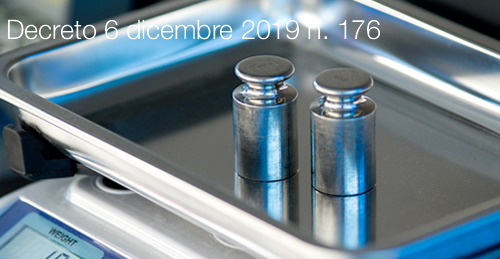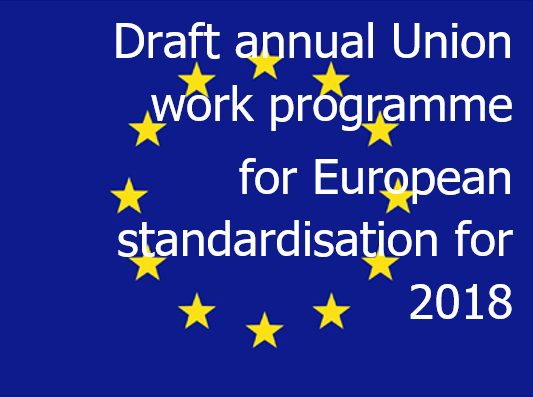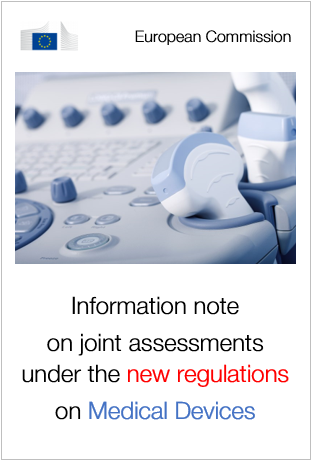Decreto 6 dicembre 2019 n. 176

Decreto 6 dicembre 2019 n. 176
Regolamento recante modifiche al decreto 21 aprile 2017, n. 93, concernente la disciplina attuativa della normativa sui controlli degli strumenti di misura in servizio e ...

Commissione Europea 11.08.2017
The Commission supports the voluntary application of standards and industry’s leading role in their development. At the same time, it considers as essential, to secure a high level of acceptance, that the standardisation process should benefit from the technical knowledge of industrial, governmental and scientific representatives and other stakeholders. The regulator can establish requirements in legislation and ask the European Standardisation System (ESS) to develop voluntary European standards (to be published in the Official Journal), which can be used for indirect reference and as a basis for a presumption of conformity or safety. An efficient standardisation system must therefore be based on close partnership between the regulator, standardisation bodies and industry.
The Commission set out a strategic vision for European standardisation in its 2011 Communication on A strategic vision for European standards: moving forward to enhance and accelerate the sustainable growth of the European economy by 2020. This was givenlegal form in Regulation (EU) N° 1025/2012 on European standardisation, which has been in force since 1 January 2013.
The Regulation requires the Commission to identify strategic priorities for European standardisation. These priorities, which reflect the Commission’s policy objectives, are published in annual Union work programmes for European standardisation (AUWPs). The AUWPs indicate what standards and standardisation deliverables the Commission intends to request from the European standardisation organisations (ESOs), i.e. how it intends to use standardisation in support of new or existing legislation and policies and what formal standardisation requests (mandates) this may involve.
Standardisation requests are essential for the functioning of the single market, since standards enable the implementation of legislative acts. This generates legal certainty for manufacturers and facilitates the development and commercialisation of products and services.
The standardisation activity prioritised in this 2018 AUWP reflects a number of the current Commission’s policy priorities, and supports recently approved major legislation and policy documents. Further important elements include action to enhance the visibility of European standardisation in other countries and international organisations, and action to improve the functioning, performance and delivery of the ESS. The Commission welcomes the European Parliament resolution of 4 July 2017 on European standards for the 21st century ("hereinafter EP report on standardisation "), and acknowledges and underlines "the opinion that standards are an important tool for the operation of the Single Market, to enhance European competitiveness, growth and innovation, to support quality, performance and protection of consumers, business, workers, and environment and to develop interoperability of networks and system". In particular, the
AUWP addresses and echoes the challenges and considerations surrounding Standards Essential Patents, on ICT standardisation, the international dimension of standardisation and on autonomous vehicles. Furthermore, the report is crucial in support of the inter-institutional reporting and dialogue and has served as an important reference for this AUWP.
The AUWP also reflects the joint initiative on standardisation (JIS), which was proposed by the Commission in 2015 (as part of the single market strategy) and signed in June 2016. The JIS sets out a shared vision that supports the Commission’s 10 policy priorities, and specific actions to be delivered by 2019 to improve the European standardisation system mobilising the EU institutions and the European standardisation community. It has been widely recognised as the way forward for European standard-setting in the light of technological development, political priorities and global trends. To date, it has been signed and endorsed by a total of 109 participants, including EU and EFTA Member States and organisations, representing a high level of engagement throughout the ESS.
This work programme:
- is addressed to all Member states, ESOs, national standardisation bodies (NSBs), AnnexIII organisations (SBS, ANEC, ETUC and ECOS) representing respectively SMEs, consumers, workers and environmental interests in standardisation, industry and other stakeholders involved in the standardisation process, and calls for their active participation in the priority actions;
- seeks to make the ESS more effective by concentrating available resources on the sectors that enable it to deliver on Commission priorities; and
- calls on ESOs to base their work programmes on implementation of the key strategies, actions and policies highlighted here.
The AUWP has no budgetary impact over and above what is already foreseen in the financial perspectives for 2018.
...
Estratto:
Draft working document on implementation of the foreseen actions
A Resilient Energy Union with a Forward-Looking Climate Change Policy
| Policy/legislative reference | Objective | Aim /impact of the action | Type of action |
|
Ambient air quality directives (Directive 2008/50/EC and Directive 2004/107/EC) |
Support for the local and regional monitoring of air quality with mobile and portable monitoring devices that meet the data quality objectives in the Ambient Air Quality Directives. Support fot the implementation of the Ambient Air Quality Directives. In order to ensure that the information collected on air pollution is sufficiently representative and comparable across the Community, it is important that standardised measurement techniques and common criteria for the number and location of measuring stations are used for the assessment of ambient air quality. Techniques other than measurements can be used to assess ambient air quality and it is therefore necessary to define criteria for the use and required accuracy of such techniques. |
The standards for air quality sensors would support for the local and regional monitoring of air quality with mobile and portable monitoring devices and the statistical processing of data in a user-friendly way. The problem to be solved is that the performance of the current generation of air quality sensors does not meet the data quality objectives in the Ambient Air Quality Directives. The standard is necessary because Member states S have identified problems with the relatively cheap sensors used by the public to measure air quality, because these sensors do not meet the data quality objectives in the Ambient Air Quality Directives . All over Europe, citizen scientists, NGOs, companies and administrations are increasingly monitoring local and regional air quality. They often use mobile monitors,portable devices and biological tools. These ways are claimed to be useful to perform measurements in or near hotspots and to establish air quality benefits near infrastructure projects to compare the situation before and after, especially if no official monitoring station is nearby. Such ways could also raise awareness of e.g. school pupils and provide support among citizens for air quality measures. The developement of a standard for air quality sensors would promote innovation, increase the quality of the portable devices and impact on jobs and competitiveness in the EU market of these sensors. |
Development of a standard for the local and regional monitoring of air quality with mobile and portable monitoring devices that meet meet the data quality objectives in the Ambient Air Quality Directives. |
|
Directive 2010/75/EU on industrial emissions (IED) |
The Directive 2010/75/EU on industrial emissions (IED) and the Commission Decisions establishing conclusions on Best Available Technique (BAT), require suitable monitoring of: the emissions of ammonia (HN3) to the air; the emissions of chlorine (and chlorine dioxide) to the air; hydrogen fluoride or total gaseous fluorides from different industrial sectors and refer to EN (or where EN standards not available ISO, national or other international equivalent) standards. There is therefore a need to develop EN standard where no EN and ISO standard are currently available. |
• The standard will be used for the continuous monitoring of ammonia (NH3) to air from the use of |
Development of a Standard to support the implementation of the Industrial Emissions Directive |
|
Directive 2009/125/EC establishing a framework for the setting of ecodesign requirements for energy-related products and associated implementing Regulations |
Standards meeting the requirements which the below listed energy-related products covered by implementing measures must fulfil in order to be placed on the market and/or put into service: computers, displays, servers and data storage devices, commercial refrigeration, electric motors, fans, lighting products, household cold appliances, standard air compressors, machine tools and external power supplies |
The standards will decrease the energy consumption of the products thus reducing the environmental impacts |
Development pf standards |
A Deeper and Fairer Internal Market with a Strengthened Industrial Base
| Policy/legislative reference | Objective | Aim /impact of the action | Type of action |
|
Directive 2006/42/EC of the European Parliament and of the Council of 17 May 2006 on machinery, and amending Directive 95/16/EC (recast) |
Mainly related to new (emerging) technologies and machinery, standards necessary for specific machinery below, as a market need identified via the open public consultation for the evaluation study of the Directive on machinery: 1) Additive manufacturing machinery (3D printing); 2) Collaborative robots; 3)Automated machines and vehicles; 4)Wind turbines; 5)Food machines |
New harmonised standards for specific types of machinery mentioned hereafter will fill in the existing gap for such innovative products which are developed at a fast pace and their spread on the European market becomes increasingly wider. In order to overcome the current situation of selfcertification conformity procedures and as such, availability of European harmonised standards is highly important both for ensuring safety and market access. Further to this, relevant international standardisation activities should be taken into account. |
Develop harmonised standards |
|
Regulation (EU) 2017/745 of the European Parliament and of the Council of 5 April 2017 on medical devices and; Regulation (EU) 2017/746 of the European Parliament and of the Council of 5 April 2017 on in vitro diagnostic medical devices |
The new Regulation reinforces safety and performance requirements for medical devices, to keep pace with technological and scientific progress. It further harmonises and clarifies the regulatory requirements to support their uniform application by the operators. Therefore, the review of the existing standards is necessary in order to align them to the requirements of the new Regulation. New standardisation requests may be considered for new types of devices, new regulated practices, or in view of the more detailed safety and performance requirements. |
uniform application of the legal requirements for placing medical devices on the market facilitation of the free movement of medical devices in the internal market |
review / update of all the existing standards (in particular, review of the scope of each standard in the light of the requirements of the new Regulation) possible development of new standards, in order to cover such matters as: (i) new types of devices; (ii) new regulated practices; (iii) more detailed safety and performance requirements |
|
Regulation 1907/2006 (REACH) |
Harmonisation of an analytical method to determine the migration of polycyclic aromatic hydrocarbons (PAHs) from plastic and rubber. The restriction in entry 50 of Annex XVII will be reviewed in late 2017 and may include a migration based derogation from the content limit already established. |
This standard will support the implementation of the restriction defined in entry 50 of Annex XVII to REACH, relative to PAHs in consumer articles containing plastic and rubber components |
Development of a harmonised standard. The standard would rely on initial method development work currently being undertaken by DG JRC Directorate D, which should conclude in late 2017 |
|
Directive 2014/34/EU of the European Parliament and of the Council of 26 February 2014 on the harmonisation of the laws of the Member States relating to equipment and protective systems intended for use in potentially explosive atmospheres. |
European harmonised standards in the ATEX sector are currently developed under the Mandates M/BC/CEN/92/46 and M/BC/CEN/92/8 issued for the previous Directive 94/9/EC. It is necessary to consolidate and update the mandate for the new Directive 2014/34/EU taking into consideration the Standardisation Regulation (EU) No 1025/2012 |
As for the other EU harmonisation legislation for products in the internal market, referred to the "New Approach" and the "New Legislative Framework", harmonised standards are a very useful mean to get presumption of conformity with the essential requirements they aim to cover. A new consolidated and updated mandate would improve the legal and technical bases for the work to be developed by the European Standardisation Organisations (CEN and CENELEC) |
Development of harmonised standards for the ATEX legislation |
Fonte: Commissione Europea

Regolamento recante modifiche al decreto 21 aprile 2017, n. 93, concernente la disciplina attuativa della normativa sui controlli degli strumenti di misura in servizio e ...

EC 13 Novembre 2017
Regulation (EU) 2017/745 on medical devices (the MDR) and Regulation (EU) 2017/746 on in vitro diag...

Scheda e Note sul nuovo Regolamento che definisce i limiti di emissione per i motori di macchine mobili non stradali.
Il regolamento 2016/1628 del ...
Testata editoriale iscritta al n. 22/2024 del registro periodici della cancelleria del Tribunale di Perugia in data 19.11.2024